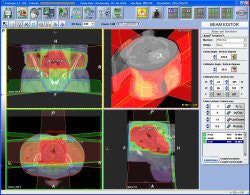
U.K. researchers have found that off-the-shelf Internet conferencing software can help improve collaboration between radiologists and radiation oncologists in ways that sophisticated PACS software can't.
Researchers from Nottingham University Hospitals NHS Trust say they use NetMeeting software from Microsoft of Redmond, WA, to facilitate communication between departments after finding shortcomings in the trust's recently installed PACS network. They say that NetMeeting helps radiologists keep in touch with their colleagues in oncology as they plan radiation therapy treatments.
The Nottingham Trust consists of two campuses located five miles apart. Radiotherapy treatment is provided at Nottingham City Hospital campus, while radiologists specializing in head and neck imaging work at the Queen's Medical Centre campus.
While the distance between the two hospitals is short, road congestion caused by heavy traffic and parking availability pose problems. A typical door-to-door trip in either direction averages 45 to 60 minutes. Because of their heavy workloads, allocating an hour of travel time from one campus to another to jointly collaborate in radiation therapy planning wasn't feasible for either group of clinicians.
The trust had hoped that collaboration between departments would improve after the installation of an enterprise PACS in 2007, but the PACS that was installed didn't support tumor outlining or provide image fusion capabilities. And because a dedicated radiotherapy resource scheduler schedules a dedicated radiotherapy CT instead of the radiology information system, it would have been difficult and time-consuming to put radiotherapy planning CT images on PACS, explained Keith Langmack, Ph.D., in an article published in the August 2008 issue of the British Journal of Radiology (Vol. 81:968, pp. 666-667).
The solution was Internet-based conferencing using the NetMeeting software, a remote desktop application of the Windows operating system. NetMeeting enables two or more users to share applications and data across a local area network (LAN) or Internet connection. At Nottingham University Hospitals, NetMeeting is being used with 3D virtual simulation software (ProSoma, MedCom, Darmstadt, Germany) used in the planning of external-beam radiation therapy.
 |
| MedCom's ProSoma software, which Nottingham clinicians use in conjunction with Microsoft's NetMeeting to plan radiation therapy sessions. Photo courtesy of MedCom. |
However, the physical separation of the Nottingham oncologists and radiologists was preventing this from happening, according to Langmack, who is head of clinical radiotherapy physics at Nottingham.
How it works
At a monthly scheduled meeting, and whenever necessary between meetings, an oncologist uses the dedicated virtual simulation workstation, opens the NetMeeting application, and initiates the session by entering the Internet protocol (IP) address of the computer of each participating radiologist. Once the connection is established on a secure 100-Mb network, all participants can see the fused image sets displayed on the virtual simulation workstation.
When a participant wants to make a change, he or she can request control of the conference session. There is a two-second time delay when adding a structure by a remote mouse, Langmack said, but users rapidly adjust to this. The system is primarily used for cases about head, neck, and brain tumors.
Conversations about cases are discussed by telephone. "We discovered that it is not possible to hold a secure NetMeeting and use audio at the same time," Langmack told AuntMinnie.com.
Four oncologists and three radiologists are currently using the system. Langmack foresees that it could also be used during the quality assurance phase of clinical trials for participants to discuss the delineation of tumors.
"Remote consultation would be very feasible using secure network links, and the advantage of this technology is that it is incorporated in every PC with no supplemental licensing fees," Langmack said.
By Cynthia Keen
AuntMinnie.com staff writer
September 8, 2008
Copyright © 2008 AuntMinnie.com

















